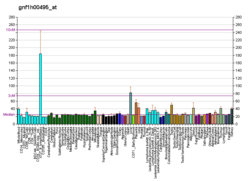SESN2
Sestrin-2 also known as Hi95 is a protein that in humans is encoded by the SESN2 gene.[4][5][6]
Function
This gene encodes a member of the sestrin family of PA26-related proteins. The encoded protein may function in the regulation of cell growth and survival. This protein may be involved in cellular response to different stress conditions.[6][7] The Sestrins constitute a family of evolutionarily-conserved stress-inducible proteins that suppress oxidative stress and regulate adenosine monophosphate-dependent protein kinase (AMPK)-mammalian target of rapamycin (mTOR) signaling. By virtue of these activities, the Sestrins serve as important regulators of metabolic homeostasis. Accordingly, inactivation of Sestrin genes in invertebrates resulted in diverse metabolic pathologies, including oxidative damage, fat accumulation, mitochondrial dysfunction and muscle degeneration that resemble accelerated tissue aging.[6][8]
Ligands
The NMDA receptor antagonist ketamine has been found to activate the mammalian target of rapamycin complex 1 (mTORC1) pathway in the medial prefrontal cortex (mPFC) of the brain as an essential downstream mechanism in the mediation of its rapid-acting antidepressant effects.[9] NV-5138 is a ligand and modulator of sestrin2, a leucine amino acid sensor and upstream regulatory pathway of mTORC1, and is under development for the treatment of depression.[9] The drug has been found to directly and selectively activate the mTORC1 pathway, including in the mPFC, and to produce rapid-acting antidepressant effects similar to those of ketamine.[9]
See also
References
- ENSG00000285069 GRCh38: Ensembl release 89: ENSG00000130766, ENSG00000285069 - Ensembl, May 2017
- "Human PubMed Reference:". National Center for Biotechnology Information, U.S. National Library of Medicine.
- "Mouse PubMed Reference:". National Center for Biotechnology Information, U.S. National Library of Medicine.
- Peeters H, Debeer P, Bairoch A, Wilquet V, Huysmans C, Parthoens E, Fryns JP, Gewillig M, Nakamura Y, Niikawa N, Van de Ven W, Devriendt K (Apr 2003). "PA26 is a candidate gene for heterotaxia in humans: identification of a novel PA26-related gene family in human and mouse". Hum Genet. 112 (5–6): 573–80. doi:10.1007/s00439-003-0917-5. PMID 12607115.
- Budanov AV, Shoshani T, Faerman A, Zelin E, Kamer I, Kalinski H, Gorodin S, Fishman A, Chajut A, Einat P, Skaliter R, Gudkov AV, Chumakov PM, Feinstein E (Aug 2002). "Identification of a novel stress-responsive gene Hi95 involved in regulation of cell viability". Oncogene. 21 (39): 6017–31. doi:10.1038/sj.onc.1205877. PMID 12203114.
- "Entrez Gene: SESN2 sestrin 2".
- Lee JH, Bodmer R, Bier E, Karin M (June 2010). "Sestrins at the crossroad between stress and aging". Aging. 2 (6): 369–74. doi:10.18632/aging.100157. PMC 2919257. PMID 20606249.
- Lee JH, Budanov AV, Karin M (Dec 2013). "Sestrins orchestrate cellular metabolism to attenuate aging". Cell Metab. 18 (6): 792–801. doi:10.1016/j.cmet.2013.08.018. PMC 3858445. PMID 24055102.
- Duman RS (2018). "Ketamine and rapid-acting antidepressants: a new era in the battle against depression and suicide". F1000Res. 7. doi:10.12688/f1000research.14344.1. PMC 5968361. PMID 29899972.
Further reading
- Gerhard DS, Wagner L, Feingold EA, et al. (2004). "The Status, Quality, and Expansion of the NIH Full-Length cDNA Project: The Mammalian Gene Collection (MGC)". Genome Res. 14 (10B): 2121–7. doi:10.1101/gr.2596504. PMC 528928. PMID 15489334.
- Budanov AV, Sablina AA, Feinstein E, et al. (2004). "Regeneration of peroxiredoxins by p53-regulated sestrins, homologs of bacterial AhpD". Science. 304 (5670): 596–600. doi:10.1126/science.1095569. PMID 15105503.
- Ota T, Suzuki Y, Nishikawa T, et al. (2004). "Complete sequencing and characterization of 21,243 full-length human cDNAs". Nat. Genet. 36 (1): 40–5. doi:10.1038/ng1285. PMID 14702039.
- Strausberg RL, Feingold EA, Grouse LH, et al. (2003). "Generation and initial analysis of more than 15,000 full-length human and mouse cDNA sequences". Proc. Natl. Acad. Sci. U.S.A. 99 (26): 16899–903. doi:10.1073/pnas.242603899. PMC 139241. PMID 12477932.
- Simpson JC, Wellenreuther R, Poustka A, et al. (2001). "Systematic subcellular localization of novel proteins identified by large-scale cDNA sequencing". EMBO Rep. 1 (3): 287–92. doi:10.1093/embo-reports/kvd058. PMC 1083732. PMID 11256614.
- Wiemann S, Weil B, Wellenreuther R, et al. (2001). "Toward a Catalog of Human Genes and Proteins: Sequencing and Analysis of 500 Novel Complete Protein Coding Human cDNAs". Genome Res. 11 (3): 422–35. doi:10.1101/gr.GR1547R. PMC 311072. PMID 11230166.


